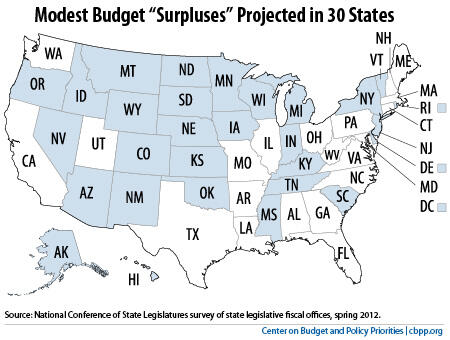off the charts
POLICY INSIGHT
BEYOND THE NUMBERS
BEYOND THE NUMBERS
As states close the books on fiscal year 2012, which ends on June 30 in most states, many expect to end the year with their budgets in the black. More than half the states reported to the National Conference of State Legislatures in April that their revenues would exceed spending for the year (see map).
But state budget problems are far from over. Until employment returns to pre-recession levels, state revenues won’t be healthy enough to avert the need for more spending cuts or to support tax cuts.
Image

Here’s what those modest “surpluses” mean — and what they don’t.
- End-of-year surpluses are normal. Generally they occur when revenues come in higher than the state estimated when enacting (or revising) its budget. Almost every state is required by law to balance its budget — in other words, revenues must meet or exceed projected spending. But, a surplus is not necessarily a sign that all is well with a state’s budget. Estimating future tax collections is inexact in the best of times. It’s even more difficult when the economy is in crisis and revenues fall by record amounts, as they have since this recession began. So it’s no surprise when a state doesn’t collect exactly the amount of revenues it projected.
- A surplus doesn’t mean the state’s revenues have recovered from the recession. Nationally, state revenues remain 7 percent below where they were at the start of the recession in 2008, after adjusting for inflation. A return to growth is a good sign, but that growth appears to be slowing. States expected their revenues to grow by less than 2 percent on average in fiscal year 2012, only about one-third of the growth of the prior year.
- The surpluses aren’t nearly large enough to reverse state spending cuts. In most states, revenues will continue to fall far short of what states need to maintain public services in fiscal year 2013 and for a couple of years beyond. As a result, states have closed or will soon close shortfalls that total almost $50 billion for 2013.
- But, a surplus does mean that the next year’s deficit-closing measures can be a bit less harsh. States relied heavily on spending cuts in all areas of state budgets – elementary and secondary education, health care, higher education, and human services – to balance their budgets over the last four years. They can use the surplus funds to restore some of these cuts or reduce new ones included in budgets for the next year.
Topics:
Stay up to date
Receive the latest news and reports from the Center
